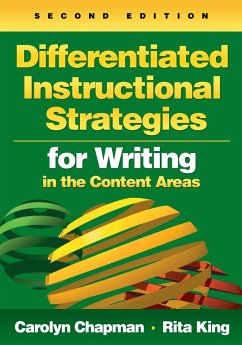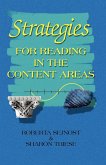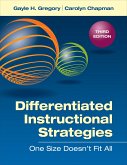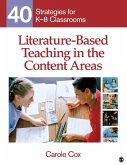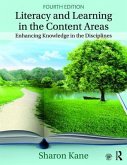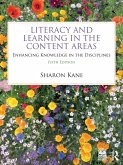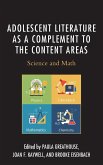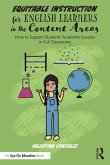- Broschiertes Buch
- Merkliste
- Auf die Merkliste
- Bewerten Bewerten
- Teilen
- Produkt teilen
- Produkterinnerung
- Produkterinnerung
Best-selling authors Carolyn Chapman and Rita King provide specific strategies for differentiating writing instruction to help students learn content and develop as writers.
Andere Kunden interessierten sich auch für
![Strategies for Reading in the Content Areas Strategies for Reading in the Content Areas]() Roberta L. SejnostStrategies for Reading in the Content Areas11,99 €
Roberta L. SejnostStrategies for Reading in the Content Areas11,99 €![Differentiated Instructional Strategies Differentiated Instructional Strategies]() Gayle H. GregoryDifferentiated Instructional Strategies39,99 €
Gayle H. GregoryDifferentiated Instructional Strategies39,99 €![Literature-Based Teaching in the Content Areas Literature-Based Teaching in the Content Areas]() Carole A. CoxLiterature-Based Teaching in the Content Areas63,99 €
Carole A. CoxLiterature-Based Teaching in the Content Areas63,99 €![Literacy and Learning in the Content Areas Literacy and Learning in the Content Areas]() Sharon KaneLiteracy and Learning in the Content Areas70,99 €
Sharon KaneLiteracy and Learning in the Content Areas70,99 €![Literacy and Learning in the Content Areas Literacy and Learning in the Content Areas]() Sharon KaneLiteracy and Learning in the Content Areas77,99 €
Sharon KaneLiteracy and Learning in the Content Areas77,99 €![Adolescent Literature as a Complement to the Content Areas Adolescent Literature as a Complement to the Content Areas]() Adolescent Literature as a Complement to the Content Areas78,99 €
Adolescent Literature as a Complement to the Content Areas78,99 €![Equitable Instruction for English Learners in the Content Areas Equitable Instruction for English Learners in the Content Areas]() Valentina Gonzalez (ESL)Equitable Instruction for English Learners in the Content Areas45,99 €
Valentina Gonzalez (ESL)Equitable Instruction for English Learners in the Content Areas45,99 €-
-
-
Best-selling authors Carolyn Chapman and Rita King provide specific strategies for differentiating writing instruction to help students learn content and develop as writers.
Produktdetails
- Produktdetails
- Verlag: SAGE Publications Inc
- Artikelnr. des Verlages: B72314P
- 2 Revised edition
- Seitenzahl: 178
- Erscheinungstermin: 30. Juli 2009
- Englisch
- Abmessung: 254mm x 178mm x 10mm
- Gewicht: 344g
- ISBN-13: 9781412972321
- ISBN-10: 1412972329
- Artikelnr.: 26014161
- Herstellerkennzeichnung
- Libri GmbH
- Europaallee 1
- 36244 Bad Hersfeld
- gpsr@libri.de
- Verlag: SAGE Publications Inc
- Artikelnr. des Verlages: B72314P
- 2 Revised edition
- Seitenzahl: 178
- Erscheinungstermin: 30. Juli 2009
- Englisch
- Abmessung: 254mm x 178mm x 10mm
- Gewicht: 344g
- ISBN-13: 9781412972321
- ISBN-10: 1412972329
- Artikelnr.: 26014161
- Herstellerkennzeichnung
- Libri GmbH
- Europaallee 1
- 36244 Bad Hersfeld
- gpsr@libri.de
Carolyn Chapman is an international educational consultant, author, and teacher who has taught in kindergarten to college classrooms. Her interactive, hands-on professional development training sessions challenge educators to use strategies that ensure success for learners of all ages. Chapman has written many books about differentiated instruction, multiple intelligences, multiple assessments, and the brain-compatible classroom. She is coauthor with Gayle Gregory of the landmark Corwin Press book Differentiated Instructional Strategies: One Size Doesn't Fit All.
About the Authors
Introduction
Infusing Writing in the Content Areas
Writing and the Brain
Rationale for Writing in the Content Areas
Turn On the Writer
Every Teacher Is a Writing Teacher: The Power Is Yours!
2. Creating a Climate for Writing
Establishing the Effective Writing Environment
Create a Safe and Positive Atmosphere
Creating a Physical Environment for Writing
Razzmatazz to Thingamajigs
Find the Write Spot
Assessing the Physical Writing Climate
Summary
3. Knowing the Writer
Stages of a Writer
Diagnosing the Writing Characters
Learning Styles and Multiple Intelligences
4. Differentiating the Writing Process and Flexible Groupings
Immerse Students in the Writer¿s Craft
Types of Writing
The Block Party
The Writing Process
Step 1: Getting Started: Prewriting
Step 2: Sloppy Copy: First Draft
Step 3: Hamming It Up: Revision
Step 4: Turning It Up: Editing
Step 5: Neat Sheet: Final Copy
Step 6: Publishing: Sharing and Celebrating
Flexible Grouping
Summary
5. Instructional Strategies and Activities for the Differentiated Writing
Classroom
Teaching Writing Strategy Strategically
Informational Text Writing and Critical Thinking
Writing Strategies for ELL Learners
Differentiating Writing With Formats and Genres
Planning for Individual Needs
Writing Strategies
Writing From A to Z
6. Planning, Assessing, and Evaluating Writing
Lesson Planning Model for Writing in the Content Areas
Effective Assessment Tools
References
Index
Introduction
Infusing Writing in the Content Areas
Writing and the Brain
Rationale for Writing in the Content Areas
Turn On the Writer
Every Teacher Is a Writing Teacher: The Power Is Yours!
2. Creating a Climate for Writing
Establishing the Effective Writing Environment
Create a Safe and Positive Atmosphere
Creating a Physical Environment for Writing
Razzmatazz to Thingamajigs
Find the Write Spot
Assessing the Physical Writing Climate
Summary
3. Knowing the Writer
Stages of a Writer
Diagnosing the Writing Characters
Learning Styles and Multiple Intelligences
4. Differentiating the Writing Process and Flexible Groupings
Immerse Students in the Writer¿s Craft
Types of Writing
The Block Party
The Writing Process
Step 1: Getting Started: Prewriting
Step 2: Sloppy Copy: First Draft
Step 3: Hamming It Up: Revision
Step 4: Turning It Up: Editing
Step 5: Neat Sheet: Final Copy
Step 6: Publishing: Sharing and Celebrating
Flexible Grouping
Summary
5. Instructional Strategies and Activities for the Differentiated Writing
Classroom
Teaching Writing Strategy Strategically
Informational Text Writing and Critical Thinking
Writing Strategies for ELL Learners
Differentiating Writing With Formats and Genres
Planning for Individual Needs
Writing Strategies
Writing From A to Z
6. Planning, Assessing, and Evaluating Writing
Lesson Planning Model for Writing in the Content Areas
Effective Assessment Tools
References
Index
About the Authors
Introduction
Infusing Writing in the Content Areas
Writing and the Brain
Rationale for Writing in the Content Areas
Turn On the Writer
Every Teacher Is a Writing Teacher: The Power Is Yours!
2. Creating a Climate for Writing
Establishing the Effective Writing Environment
Create a Safe and Positive Atmosphere
Creating a Physical Environment for Writing
Razzmatazz to Thingamajigs
Find the Write Spot
Assessing the Physical Writing Climate
Summary
3. Knowing the Writer
Stages of a Writer
Diagnosing the Writing Characters
Learning Styles and Multiple Intelligences
4. Differentiating the Writing Process and Flexible Groupings
Immerse Students in the Writer¿s Craft
Types of Writing
The Block Party
The Writing Process
Step 1: Getting Started: Prewriting
Step 2: Sloppy Copy: First Draft
Step 3: Hamming It Up: Revision
Step 4: Turning It Up: Editing
Step 5: Neat Sheet: Final Copy
Step 6: Publishing: Sharing and Celebrating
Flexible Grouping
Summary
5. Instructional Strategies and Activities for the Differentiated Writing
Classroom
Teaching Writing Strategy Strategically
Informational Text Writing and Critical Thinking
Writing Strategies for ELL Learners
Differentiating Writing With Formats and Genres
Planning for Individual Needs
Writing Strategies
Writing From A to Z
6. Planning, Assessing, and Evaluating Writing
Lesson Planning Model for Writing in the Content Areas
Effective Assessment Tools
References
Index
Introduction
Infusing Writing in the Content Areas
Writing and the Brain
Rationale for Writing in the Content Areas
Turn On the Writer
Every Teacher Is a Writing Teacher: The Power Is Yours!
2. Creating a Climate for Writing
Establishing the Effective Writing Environment
Create a Safe and Positive Atmosphere
Creating a Physical Environment for Writing
Razzmatazz to Thingamajigs
Find the Write Spot
Assessing the Physical Writing Climate
Summary
3. Knowing the Writer
Stages of a Writer
Diagnosing the Writing Characters
Learning Styles and Multiple Intelligences
4. Differentiating the Writing Process and Flexible Groupings
Immerse Students in the Writer¿s Craft
Types of Writing
The Block Party
The Writing Process
Step 1: Getting Started: Prewriting
Step 2: Sloppy Copy: First Draft
Step 3: Hamming It Up: Revision
Step 4: Turning It Up: Editing
Step 5: Neat Sheet: Final Copy
Step 6: Publishing: Sharing and Celebrating
Flexible Grouping
Summary
5. Instructional Strategies and Activities for the Differentiated Writing
Classroom
Teaching Writing Strategy Strategically
Informational Text Writing and Critical Thinking
Writing Strategies for ELL Learners
Differentiating Writing With Formats and Genres
Planning for Individual Needs
Writing Strategies
Writing From A to Z
6. Planning, Assessing, and Evaluating Writing
Lesson Planning Model for Writing in the Content Areas
Effective Assessment Tools
References
Index

